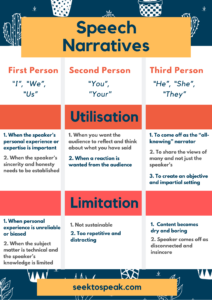When writing an academic paper, why do academicians write in a clinical, third-person point of view? When reading a fictional book, why is the story usually told from the protagonist’s perspective? When writers decide to write, they also decide the type of tone and effect they want to have on their readers. They do this through the creative use of various narratives. Why then is the same thought process not utilised when speakers craft speeches?
People typically write their speech as it is verbalised. Most only decide on its structure and include their points in summary – only to include transitions when delivering the speech. Whilst this is beneficial to prevent speakers from being rigid with their delivery, it also means that most speakers do not think about how their sentences should be phrased and in particular, which narrative to take. Planning and strategising how to phrase your speech will go a long way in controlling how you want your audience to feel and how you want to be perceived.
Narratives
For example, on the topic of, “Mental Health”, there are three ways I can choose to start my speech:
Example 1
“I have been battling with issues on depression for a while now. It has taken me a lot of time to come to terms with the fact that this is not my fault and that no one is to be blamed for my condition. There will always be bad days but there will be good days as well. I remind myself every day that I will constantly be a work in progress and that my mental health is something I should value and not take for granted”
OR
Example 2
“Do you sometimes feel like the weight of the world is on your shoulders? Does the thought of getting up in the morning to face the world make you cringe? Do you notice that you seem to sleep a lot more than you used to and even the most trivial of social interactions exhaust you? Well, you are not alone.”
OR
Example 3
“The World Health Organization estimates that around 300 million people around the world have depression and that one million people die each year from suicide. This represents a global mortality rate of 16 people per 100,000 or one death every 40 seconds. With a problem so widespread and the effects, so grave, it is a wonder that governments do not do more to deal with mental health issues.”
Is there any difference in the way you would react to the 3 examples above?
Effect
You would most likely feel compassion towards the speaker in Example 1 as she has shared a very difficult part of her life. It makes you root for her as she comes off as honest and sincere in her beliefs. You also trust her views because she has experienced the problem first-hand.
Example 2 makes you think about your own life. Do you have these symptoms? What are these symptoms? If so, can the speaker help? You listen to the speaker because the speaker addresses you as a person and brings you into the fold. The speaker makes you reflect on yourself and your own life.
Example 3 makes you believe in the speaker as the speaker is imparting surprising facts which you were not aware of, and are now worried about. You are most likely to agree or believe in what the speaker says because she appears credible and highly knowledgable in the field.
See how each narrative presented a different effect on the audience?
Differences
There are 3 different types of narratives that can be used in a speech;
1) First-Person point of view: referring to the speaker and his/her personal opinions as well as experiences, i.e. I, My, Us, Our
2) Second-Person point of view: referring to the audience directly and relates to their own personal opinions and experiences, i.e. You, Your
3) Third-Person point of view: referring to other people’s opinions or experiences such as an expert, a close friend or family member, i.e. He, She, They, Them
These narratives have various advantages and disadvantages when used in a speech. A good speaker knows when and where to place such narratives.
When to use?
In general, here are my thoughts on the various instances such narratives should be utilised along with their respective limitations:
